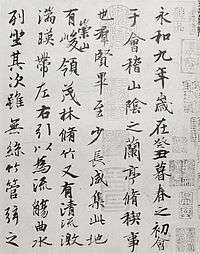Semi-cursive script
| Semi-cursive script | |
|---|---|
 | |
| Type | |
| Languages | Old Chinese, Middle Chinese, Modern Chinese |
Time period | Han Dynasty to present |
Parent systems |
Oracle bone script
|
Child systems |
Regular script Zhuyin Simplified Chinese Chu Nom Khitan script Jurchen script Tangut script |
| 4E00–9FFF, 3400–4DBF, 20000–2A6DF, 2A700–2B734, 2F00–2FDF, F900–FAFF | |
| Semi-cursive script | |||||||||||||||||||||||||
|
Chinese characters of "Semi-cursive Script" in regular script (left) and semi-cursive script (right). | |||||||||||||||||||||||||
| Chinese name | |||||||||||||||||||||||||
|---|---|---|---|---|---|---|---|---|---|---|---|---|---|---|---|---|---|---|---|---|---|---|---|---|---|
| Traditional Chinese | 行書 | ||||||||||||||||||||||||
| Simplified Chinese | 行书 | ||||||||||||||||||||||||
| |||||||||||||||||||||||||
| Vietnamese name | |||||||||||||||||||||||||
| Vietnamese alphabet |
1. hành thư[1] 2. chữ hành | ||||||||||||||||||||||||
| Hán-Nôm |
1. 行書 2. 𡨸行 | ||||||||||||||||||||||||
| Korean name | |||||||||||||||||||||||||
| Hangul | 행서 | ||||||||||||||||||||||||
| Hanja | 行書 | ||||||||||||||||||||||||
| |||||||||||||||||||||||||
| Japanese name | |||||||||||||||||||||||||
| Kanji | 行書 | ||||||||||||||||||||||||
| Kana | ぎょうしょ | ||||||||||||||||||||||||
| |||||||||||||||||||||||||
| Wikimedia Commons has media related to Semi-cursive script. |
Semi-cursive script is a cursive style of Chinese characters. Because it is not as abbreviated as cursive, most people who can read regular script can read semi-cursive.
Also referred to in English both as running script and by its Mandarin Chinese name, xíngshū, it is derived from clerical script, and was for a long time after its development in the 1st centuries AD the usual style of handwriting.
Some of the best examples of semi-cursive can be found in the work of Wang Xizhi (321-379) of the Eastern Jin Dynasty.
References
This article is issued from Wikipedia - version of the 11/18/2016. The text is available under the Creative Commons Attribution/Share Alike but additional terms may apply for the media files.
